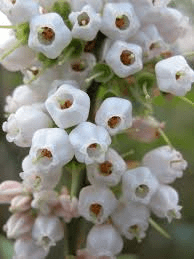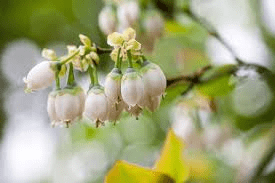Blueberry flowers are delicate, bell-shaped blossoms that bloom on the blueberry plant (Vaccinium spp.). These flowers are a defining feature of the plant and play a crucial role in its reproductive cycle, ultimately leading to the formation of the delicious and nutritious blueberries.
Blueberry flowers typically emerge in spring, often before or alongside the development of new leaves on the plant. They are usually small, with five petals fused together to form a bell-shaped corolla. The flowers may vary in color depending on the species and variety of blueberry, ranging from white to shades of pink.
Each blueberry flower contains both male and female reproductive organs. The stamens, the male reproductive organs, produce pollen, while the pistil, the female reproductive organ, contains the stigma, style, and ovary where fertilization occurs.
Pollination is essential for the development of blueberries. Pollen is transferred from the stamens to the stigma, either by wind or by pollinators such as bees, butterflies, or other insects. Once pollinated, the flowers begin to develop into fruit, with the ovary swelling and maturing into the familiar blueberry.
After pollination, the petals of the blueberry flowers may wither and fall away, leaving behind the developing fruit. The ovaries of the flowers continue to grow and mature into blueberries over the following weeks, eventually ripening and becoming ready for harvest.
Overall, blueberry flowers are not only beautiful but also essential for the reproduction and fruiting of the blueberry plant. They mark the beginning of the delicious journey that leads to the formation of the beloved blueberries enjoyed by people around the world.
The Economic Importance and Uses of Blueberry Flowers
1. Pollination and Fruit Production: Blueberry flowers are integral to the pollination process, as they attract bees and other pollinators. Without adequate pollination, blueberry plants would not produce fruits, impacting the commercial blueberry industry significantly. These flowers serve as the starting point for the formation of blueberries, a popular and economically important fruit consumed worldwide.
2. Commercial Blueberry Cultivation: The cultivation of blueberries for commercial purposes heavily relies on the successful flowering of blueberry plants. The flowers eventually develop into the fruits that are harvested and sold in markets, contributing to the agricultural economy.
3. Ornamental Horticulture: Beyond their practical role in fruit production, blueberry flowers are valued for their aesthetic appeal. Many cultivars of blueberry plants are chosen for their showy flowers, enhancing the visual appeal of gardens and landscapes. Ornamental blueberry varieties are often used in landscaping projects, adding color and texture to outdoor spaces.
4. Honey Production: Blueberry flowers provide an important nectar source for honeybees. Beekeepers rely on blueberry blossoms as part of their honey production operations. Blueberry honey, with its distinct flavor profile, is sought after by consumers and contributes to the profitability of beekeeping businesses.
5. Medicinal Uses: In traditional medicine practices, extracts from blueberry flowers are utilized for their potential health benefits. These include anti-inflammatory and antioxidant properties. While modern scientific research is ongoing to validate these claims, blueberry flowers hold a place in herbal remedies and alternative medicine systems.
6. Culinary Applications: Blueberry flowers can be incorporated into culinary creations for both visual appeal and flavor. Their delicate appearance makes them suitable for use as edible garnishes in salads, desserts, and beverages. Additionally, some culinary enthusiasts experiment with infusing dishes with the subtle floral essence of blueberry flowers.
7. Perfumery: The fragrance of blueberry flowers is captured and utilized in the perfume industry. Perfume makers extract the essence of these flowers to create fragrances with floral notes. Blueberry flower scents add depth and complexity to perfumes, colognes, and other fragrant products.
8. Herbal Teas: Dried blueberry flowers are used to brew herbal teas. These teas are appreciated for their mild flavor and potential health-promoting properties. Blueberry flower tea is often enjoyed for its soothing and relaxing qualities, making it a popular choice among tea enthusiasts.
9. Landscape Design: Blueberry flowers are incorporated into landscape design to enhance the beauty of outdoor spaces. Their vibrant colors and delicate blooms add visual interest to gardens, parks, and public landscapes. Landscape architects and designers often select blueberry varieties for their ornamental value.
10. Beekeeping Support: Blueberry flowers play a vital role in supporting bee populations. Beekeepers place their hives near blueberry fields to allow bees to forage on the nectar-rich blossoms. Blueberry flower nectar contributes to the overall health and productivity of bee colonies, benefiting both beekeepers and agricultural ecosystems.
11. Ecological Importance: Blueberry flowers contribute to biodiversity by providing food and habitat for pollinators and other wildlife species. They are part of the intricate web of interactions in natural ecosystems, supporting the survival of various organisms.
12. Wedding and Event Decor: Blueberry flowers are favored by florists for use in wedding bouquets, centerpieces, and event decorations. Their romantic symbolism and natural beauty make them a popular choice for special occasions.
13. Botanical Research: Botanists and researchers study blueberry flowers to better understand plant reproduction, genetics, and adaptation. Research on blueberry flowers informs agricultural practices and contributes to the conservation of native plant species.
14. Traditional Crafts: Blueberry flowers are sometimes incorporated into traditional crafts, such as floral arrangements, wreath-making, and botanical art. Crafters use these flowers to create decorative items that celebrate nature’s beauty.
15. Landscape Restoration: Blueberry flowers are used in ecological restoration projects to reintroduce native plant species and enhance biodiversity in degraded habitats. By including blueberry plants in restoration efforts, conservationists help restore ecological balance and promote habitat resilience.
16. Floral Industry: Blueberry flowers are valued by the floral industry for their beauty and versatility. Florists use these flowers in arrangements for various occasions, from weddings to everyday floral designs.
17. Aromatherapy: Blueberry flower essences are used in aromatherapy for their calming and uplifting effects on mood and emotions. The subtle fragrance of blueberry flowers is believed to promote relaxation and stress relief, making them a popular choice in aromatherapy blends.
Read Also: The Curry Leaves: Economic Importance, Uses, and By-Products
The Products and By-products That Can Be Derived From Blueberry Flowers

1. Blueberry Honey: Bees collect nectar from blueberry flowers to produce blueberry honey, which is prized for its unique flavor and potential health benefits. Blueberry honey is often marketed as a specialty honey variety due to its distinctive taste and aroma.
2. Herbal Teas: Dried blueberry flowers are used to brew herbal teas, enjoyed for their subtle flavor and soothing properties. Blueberry flower tea is caffeine-free and is often consumed for relaxation and as a natural remedy for various ailments.
3. Perfume Extracts: Blueberry flower extracts are used in perfumery to create fragrances with floral notes, adding depth and complexity to perfumes and colognes. The delicate scent of blueberry flowers lends a fresh and uplifting aroma to fragrant products.
4. Botanical Skincare: Extracts from blueberry flowers are incorporated into botanical skincare products for their potential antioxidant and anti-inflammatory properties. Blueberry flower extracts are believed to nourish and protect the skin, making them a popular ingredient in natural skincare formulations.
5. Culinary Garnish: Blueberry flowers are used as edible garnishes in culinary dishes, adding a touch of color and elegance to salads, desserts, and beverages. Fresh blueberry flowers can be sprinkled over dishes or used to decorate plates for a visually appealing presentation.
6. Landscape Design Elements: Fresh or dried blueberry flowers are used in landscape design for their aesthetic appeal, incorporated into gardens, flower beds, and floral arrangements. Blueberry flowers add a pop of color and texture to outdoor spaces, enhancing the overall beauty of landscaping projects.
7. Natural Dye: Blueberry flowers can be used to create natural dyes for textiles and crafts, producing shades of blue, purple, and pink. The petals of blueberry flowers contain pigments that can be extracted and used to dye fabrics, yarns, and other materials.
8. Floral Waters: Blueberry flower distillates are used to produce floral waters, which are used in skincare, aromatherapy, and natural cleaning products. Blueberry flower water is valued for its delicate fragrance and skin-soothing properties, making it a popular ingredient in cosmetic formulations.
9. Potpourri Ingredients: Dried blueberry flowers are included in potpourri mixes for their delicate fragrance and visual appeal. Blueberry flowers add a sweet and floral scent to potpourri blends, creating a refreshing and inviting atmosphere in homes and spaces.
10. Botanical Art: Blueberry flowers are used as subjects in botanical art, including paintings, drawings, and pressed flower arrangements. Artists and botanical illustrators capture the intricate details of blueberry flowers, preserving their beauty in works of art.
11. Herbal Remedies: Blueberry flower extracts are used in herbal remedies for their potential health benefits, including anti-inflammatory and antioxidant properties. Blueberry flower preparations are believed to support overall health and well-being, promoting vitality and resilience.
12. Wedding Decorations: Fresh or dried blueberry flowers are used in wedding decorations, including bouquets, boutonnieres, centerpieces, and floral arches. Blueberry flowers symbolize love, happiness, and fertility, making them a meaningful choice for wedding florals.
13. Floral Jewelry: Blueberry flowers can be preserved and incorporated into floral jewelry, such as resin pendants or pressed flower earrings. Blueberry flower jewelry allows wearers to carry a piece of nature with them, celebrating the beauty of botanicals.
14. Floral Infusions: Blueberry flowers are infused into oils, vinegars, and syrups for culinary and cosmetic purposes, adding a subtle floral flavor and aroma. Blueberry flower infusions are used to flavor sauces, dressings, and desserts, imparting a delicate floral essence to dishes.
15. Botanical Studies: Blueberry flowers are used in botanical studies and research to understand plant morphology, reproductive biology, and genetic diversity. Researchers analyze blueberry flower structures and characteristics to gain insights into plant evolution and adaptation.
16. Sustainable Agriculture: Blueberry flowers are integral to sustainable agriculture practices, supporting pollinator populations and enhancing ecosystem services in agroecosystems. By promoting biodiversity and ecological balance, blueberry flowers contribute to the long-term sustainability of agricultural landscapes.
17. Cultural Artifacts: Blueberry flowers hold cultural significance in some indigenous cultures, where they are used in ceremonial rituals, storytelling, and traditional crafts. Blueberry flowers symbolize connection to nature, community, and spiritual beliefs, enriching cultural traditions and practices.
Read Also: The Curry Leaves: Economic Importance, Uses, and By-Products
Frequently Asked Questions (FAQs) About Blueberry Flowers

1. Are blueberry flowers edible?
Yes, blueberry flowers are edible and can be used as garnishes in culinary dishes or brewed into herbal teas.
2. Do blueberry flowers have a scent?
Yes, blueberry flowers have a delicate floral scent, which is often utilized in perfumery and aromatherapy.
3. How long do blueberry flowers bloom?
Blueberry flowers typically bloom for a few weeks in spring, depending on climate and growing conditions.
4. Are blueberry flowers self-pollinating?
Some blueberry varieties are self-pollinating, while others require cross-pollination from nearby plants to produce fruit.
5. Can blueberry flowers be dried for crafts?
Yes, blueberry flowers can be dried and used in various crafts, such as floral arrangements, potpourri, and botanical art.
6. What colors are blueberry flowers?
Blueberry flowers range in color from white to pink, with variations depending on the specific cultivar.
7. Are blueberry flowers toxic to pets?
While blueberries themselves are safe for pets, some caution is advised with blueberry flowers. It’s best to keep pets from consuming large quantities of any plant material to avoid potential gastrointestinal upset.
8. Can blueberry flowers be used in landscaping?
Yes, blueberry flowers are often used in landscaping for their aesthetic appeal and low maintenance requirements. They can be planted as ornamental shrubs or included in mixed flower beds for added color and texture.
9. Do blueberry flowers attract bees?
Yes, blueberry flowers are attractive to bees and other pollinators due to their nectar and pollen rewards. Beekeepers often place their hives near blueberry fields during bloom to take advantage of this resource.
10. How can I encourage blueberry flowers to bloom?
To encourage blueberry flowers to bloom, ensure that the plants receive adequate sunlight, water, and nutrients. Pruning and proper care can also promote healthy flower production.
Read Also: How to Properly Dispose your Electronic Wastes (E-Wastes)
